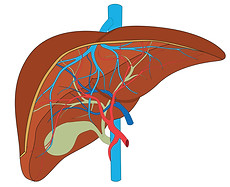Primary Biliary Cholangitis

Primary biliary cholangitis (PBC) is a chronic disease in which the small bile ducts in the liver become inflamed and are eventually destroyed. Loss of bile ducts, results in bile builds up causing liver damage. Over time, this damage can cause liver scarring, cirrhosis, and eventually liver failure. PBC believed to be an autoimmune disease in which a person’s own immune system becomes overactive and attacks normal, healthy bile duct cells. The disease used to be called primary biliary cirrhosis. Researchers estimated that in 2014 about 58 out of every 100,000 U.S. women and about 15 out of every 100,000 U.S. men had PBC.1 PBC is classified as a rare disease. It is more common in women than in men and in people who are middle aged. The average age at diagnosis is 60.2 years. Additional information on PBC can be found from the American Liver Foundation (https://liverfoundation.org/primary-biliary-cholangitis/), NIDDK (https://www.niddk.nih.gov/health-information/liver-disease/primary-biliary-cholangitis).
References
-
Lu M, Zhou Y, Haller IV, et al. Increasing prevalence of primary biliary cholangitis and reduced mortality with treatment. Clinical Gastroenterology and Hepatology. 2018;16(8):1342–1350.e1. doi: 10.1016/j.cgh.2017.12.033.
-
Lu M, Li J, Haller IV, et al. Factors associated with prevalence and treatment of primary biliary cholangitis in united states health systems. Clinical Gastroenterology and Hepatology. 2018;16(8):1333–1341.e6. doi: 10.1016/j.cgh.2017.10.018.
